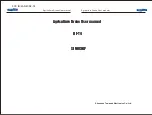
PRISM FLIGHT MANUAL
41
At neutral control input (center pitch and roll stick position) the RPA will remain level and
not increase or decrease altitude. See Caution below.
Altitude rate of change is controlled by the amount of deviation from center point of the
throttle stick. The higher the throttle stick position, the faster the climb. Conversely, the
lower the throttle stick position, the faster the RPA will descend.
This flight mode uses GPS inputs to maintain position during flight. Pilot inputs via
the pitch/roll sticks command changes in ground speed. Pitch and roll stick deflection
will command fore/aft and left/right ground speeds respectively. Controlling altitude in
POSHOLD mode is the same as in ALTHOLD. With pitch and roll controls centered, the
RPA will attempt to hold its current position and altitude. The aircraft will self-correct for
disturbances that may force it from the desired position.
Auto mode instructs the RPA to follow the waypoint mission plan uploaded to the autopilot
system. The pilot will only have manual control of the RPA heading while the mission is
being carried out. The autonomous mission can be paused at any time by toggling the
flight mode switch on the RPS. To exit AUTO mode, the user can simply flip the switch
into either ALTHOLD or POSHOLD.
7.4.2 POSITION HOLD
7.4.3 AUTO MODE
CAUTION:
This flight mode does not provide any lateral positional control of the RPA. PIC must be aware that
the RPA will drift if any wind.
CAUTION:
This mode requires a strong GPS signal and communication with a minimum of 6 satellites.
Although the GPS system functions without issue most of the time, it is still vulnerable to
interference from outside elements.
This interference may be caused by multipath error, solar storms, operation in close proximity to
powerful radio transmitters or operations within urban canyons.
If a weak signal is present, the RPA will not enter POSHOLD Mode. If the GPS signal degrades while
in POSHOLD Mode, the aircraft will automatically revert to ALTHOLD Mode.
CAUTION:
Although the mission can initiate an automatic take off and landing, it is highly recommended that
the PIC perform a manual take off and landing.
Содержание PRISM R.P.A.S.
Страница 3: ...PRISM FLIGHT MANUAL 3 INTENTIONALLY LEFT BLANK...
Страница 5: ...PRISM FLIGHT MANUAL 5 INTENTIONALLY LEFT BLANK...
Страница 6: ...PRISM FLIGHT MANUAL 6 RECORD OF REVISIONS REVISION No 1 PAGES 16 113 2 5 21 EFFECTIVE DATE REVISION...
Страница 7: ...PRISM FLIGHT MANUAL 7 INTENTIONALLY LEFT BLANK...
Страница 18: ...PRISM FLIGHT MANUAL 18 Figures 5 6 PRISM PAYLOAD AND FLIGHT TIME CALCULATIONS...
Страница 21: ...PRISM FLIGHT MANUAL 21 Figure 7 RPA ORIENTATION DURING TAKEOFF LANDING...
Страница 47: ...PRISM FLIGHT MANUAL 47 Figure 8 PRISM POWER CIRCUIT DIAGRAM...
Страница 53: ...PRISM FLIGHT MANUAL 53...
Страница 54: ...PRISM FLIGHT MANUAL 54...
Страница 57: ...PRISM FLIGHT MANUAL 57 Figure 14 20 WATTSQGC APPLICATION SETTINGS GENERAL...
Страница 67: ...PRISM FLIGHT MANUAL 67 Figure 31 COMPASS CALIBRATION SCREEN...
Страница 81: ...PRISM FLIGHT MANUAL 81 Figure 46 47 USER SELECTABLE TELEMETRY VALUES FOR HUD...
Страница 84: ...PRISM FLIGHT MANUAL 84 Figure 50 51 WATTSQGC PRE FLIGHT CHECKLIST...
Страница 103: ...PRISM FLIGHT MANUAL 103 Assembled battery pack Smaller battery assembly Assembled battery pack...
Страница 106: ...PRISM FLIGHT MANUAL 106 Battery Packs Top Mounted Battery Packs Bottom Mounted...
Страница 136: ...PRISM FLIGHT MANUAL 136 SUPPLEMENT 1...
Страница 137: ...PRISM FLIGHT MANUAL 137 SUPPLEMENT 2A...
Страница 138: ...PRISM FLIGHT MANUAL 138 SUPPLEMENT 2B...
Страница 139: ...PRISM FLIGHT MANUAL 139 SUPPLEMENT 3...
Страница 140: ...PRISM FLIGHT MANUAL 140 SUPPLEMENT 4A...
Страница 141: ...PRISM FLIGHT MANUAL 141 SUPPLEMENT 4B...












































